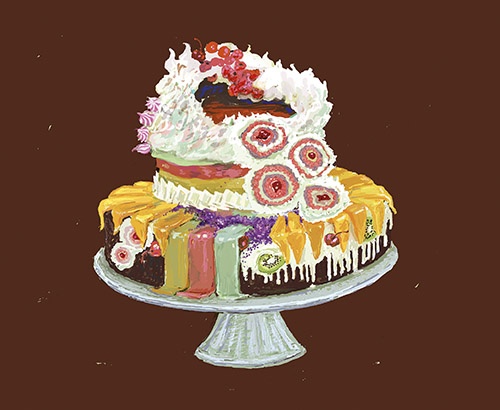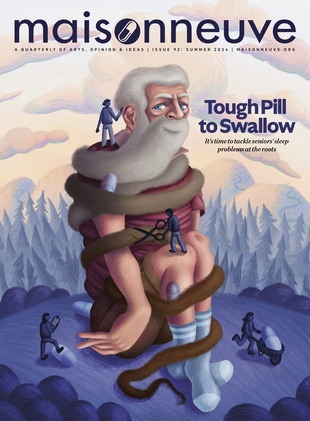 Illustration by Tine Modeweg-Hansen
Illustration by Tine Modeweg-Hansen
An Ugly, Sweet Thing
Abandoning the desire to make a perfect cake, Chantal Braganza finds meaning in the mess.
A few years ago, after watching a sci-fi movie, I felt like making a cake. An ugly one, with weird frosting patterns that didn’t repeat themselves and pieces of fruit popping out of random places. I wanted something decidedly antithetical to the cheerful spirit of pastry and more like metastasized cancer cells, which feature prominently in Annihilation, the film I had watched.
In it, Natalie Portman plays a biologist and military veteran on a mission to investigate a swampland where an alien presence is rearranging the ecological environment on a cellular level to the point of irrecognition. A fleshless bear inherits the voice of a woman it kills; a man’s intestines twist themselves into knots until they burst free of his body, burrowing into a nearby wall and blooming like the spores of a colourful fungus.
This sudden desire to make an ugly, sweet thing felt like my first real drive to do anything outside of the daily mechanics of keeping myself and my first child fed, clothed and housed in months. I didn’t understand it as such then: my son was a toddler at the time and if I was experiencing a postpartum mood disorder, it was less likely to have been clinically acknowledged so late in the game.
My days, both good and bad, felt like I had been holding my breath. I was waiting for anything reminiscent of the person I was before giving birth to come back to me, in whatever breaks existed between returning to work and taking care of a child. That exhale never came, but wanting to make this cake felt close.
I dove right in, baking a basic flat sheet of chocolate sponge and covering it in little spires of unevenly piped frosting—greyish lilac, dusty rose pink, dull white—with raspberries pushed in at odd angles. Eating the mild depression dessert didn’t make me feel better, but looking at it—eerie, pretty, but still aesthetically wrong—somehow did. So I made my funny little cake, had a slice, and then went on with my life.
Years later, in the throes of a second- or third- or who-knows-what pandemic wave lockdown and pregnant with my second child, I saw the cake again while insomnia-scrolling on Instagram. Not the one I’d made, but something so similar in spirit: an unholy, multi-tiered mess of electric pink icing covered in so much fuchsia glitter and maraschino syrup that it was caving under its own weight. Within a week the algorithm was showing me a steady stream of this kind of pastry. Cakes with pecan warts, cakes the sickly grey colour of a rouged and powdered corpse, cakes with such molten technicolour shapes they were hardly recognizable as anything made for human consumption.
Their presentation didn’t seem purposefully ugly so much as chaotic, as if the pools of icing and messily laid fondant were resulting from the cake being run through FaceTune a few too many times. Torqued, even. They were glorious, and I couldn’t get enough.
Whether we like it or not, modern cakes—the ones that emerged during the seventeenth and eighteenth centuries—have often mattered more for how they look than how they taste. By the mid-nineteenth century, British royal weddings featured cakes that were seven feet tall and decorated with elaborate, architectural sugar work. This necessitated enormously skilled cake decorators, a luxury that was only financially viable for the most wealthy. The cakes themselves may or may not have been cut and eaten; this part wasn’t the point.
In an early episode of The Nanny, the nineties sitcom that sees Fran Drescher au pairing a widowed Broadway producer’s three children, she knocks a plaster cake with a wooden spoon as she explains to Niles, the butler, why she brings the fake confection to parties. Yes, it was the nineties and yes, all the guests were presumed to be on a diet, but the fawning over the marquee dessert was kind of the only reason it was there to begin with. This makes pastry particularly well-suited to highly stylized food’s function on Instagram as an aspirational symbol—at once consumable, inconsumable, and rendered consumable again by the nature of its depiction. It also makes cake an ideal vehicle for calling the aesthetic bluff of the genre’s visual conventions.
While the online pastry aesthetics have mostly moved on from the showy cartoon gestures of the Cake Boss era or status wedding cakes and their multi-tiered towers of sugar flora, they still exist under requirements of perfection of their own making, whether it be a particular colour scheme or expository piping sequence. “Instagram cakes as we’ve come to know them are polished, and to make one requires abiding by a set aesthetic,” food writer Bettina Makalintal wrote in September 2020 for Munchies about these chaos cakes. She noted the difference between them and their primly piped counterparts, or dreamscape sheet cakes painted not unlike an early Cézanne, a palette knife applying dyed frosting to sponge like a canvas.
Even the wacky gotcha spirit of the “Is it cake?” meme, TikTok genre and eventual Netflix series, in which cakes are styled to within an inch of their lives to trick people into thinking they are jars of mayonnaise, cell phones, debit machines, human limbs—anything but a sweet—abides by strict rules of verisimilitude. These cakes exist only for the intended shock at a knife being pressed into their layers.
By contrast, the cakes I loved looking at were photographed under harsh flash lighting, caving in, messily piped, sometimes with a mirror propped up for full lurid effect—often with the most delicious descriptions of flavour composition. A berry-black cake with pimply icing and jello pods styled to look like pustules might read in the caption, “matcha sponge, lemon curd filling, gooseberry jam glaze,” or another with over-toasted meringue made to look like literal scorched earth: “vanilla ice cream, Nutella ribbons, passionfruit mousse, coconut meringue.”
That dissonance between stylized construction and flavour was a special treat. It often felt as though chaos cakes represented the logical conclusion of what food on Instagram has become: images of a consumable so forced to be more of itself that it self-destructs in the process, a carnivalesque display with cakes the medium. Things that hover between the space of beauty and ugliness are meant to inspire an uneasy feeling, but that’s not really the case here. There is a kind of relief in things that call an aesthetic bluff, which is what these cakes did.
More than halfway through Pure Colour, Sheila Heti’s novel on the experience of being alive, and being dead, then alive again, her protagonist Mira recalls an afternoon with Annie, a great love in her life. They visit a chocolate shop where Annie spots a dove-grey crystal sweet, cut with facets like a jewel and glinting at her from a window display. Only the sweet is not firm and sugar-hard, the way Annie imagines it, but made of jelly.
As Mira learns this upon ordering their afternoon snack, she must inform Annie of the minor letdown, all while she’s grieving her recently deceased father and trying to win Annie’s affection. Only in the end, it isn’t a letdown; simply a misunderstanding of the candy’s purpose. “They were going to have tea, cookies and chocolate, but not the beautiful dove-grey crystal candy that Annie originally had in mind,” Heti writes. “Annie had realized it was better to look at them than to have them, which is true of some things in this world.”
A few months after that first series of chaos cakes I clocked on the internet, I started to post images of my favourites onto Instagram Stories. A few friends glommed onto a particular style: primary colours with plenty of piped icing and cherries, almost instigative in their prim festoonery, as though they dared you to judge. “When I was little I had a children’s book that featured the most glossy, sumptuous paintings of this kind of cake, and it created a mythological sense of what they might taste like,” wrote one friend. “It was like my mind conjured up a platonic ideal of DELICIOUS DESSERT, but it wasn’t based on any real flavours.” Indeed, a flavour might have ruined the memory.
I’ve since come to understand decorated cakes—as a visual medium, a status statement, a sense memory—as being first and foremost embodiments of desire. One could have a life-changing experience through the act of eating dessert in a thousand other ways. Countless other types of confections exist to provide this sensory experience: a bite of panna cotta quivering off the spoon, the syrupy crunch of a freshly fried jalebi, a chocolate chip cookie engineered and baked to exactly your preferred intersection of crisp and chew. No visual representation can mimic their experience. Unlike a decorated cake, that isn’t their first purpose.
What embodied desire did scrolling through these chaos cakes offer me? In speaking to some of the bakers behind them for the New York Times last fall, food writer Alicia Kennedy had a compelling observation: that they stood “against nostalgia and perfection in part because there’s no use looking back, because things are neither clean nor ideal as a pandemic rages on and fires or floods overtake America’s coasts.”
Perhaps, on an interior level, their disorienting nature seemed tonally right for what it feels like for desire, of any kind, to become unrecognizable to oneself, or to disappear completely. It’s what depression is. It’s what Annihilation—a film about a depressed woman perplexed but unfazed by, and even numb to, her increasingly horrifying surroundings—was about. When I think of those moments now, both my own chaotic cake-making and the period during which I became obsessed with looking at other people’s creations, I better understand them as being indicative of a perinatal mood disorder. How ridiculous, and how lucky am I, to say that cake was one way of looking at it?
Shortly before my thirty-fifth birthday this year, I ordered a cake for myself. Layers of sponge cake soaked in condensed milk and sheathed in mango sliced to look like petals. A bit of piping on the side, with a little awkward globe of scooped fruit in the middle, made to look like a soft jewel or gaping eye. It wasn’t a chaos cake—in fact, it was wildly delicious, a condensed milk cross between mango kulfi and a tres leches dessert—and it was perfect. Ornate, decorated, only just slightly off-kilter. ⁂
Chantal Braganza is a writer and deputy editor at Chatelaine magazine. She lives in Toronto.





